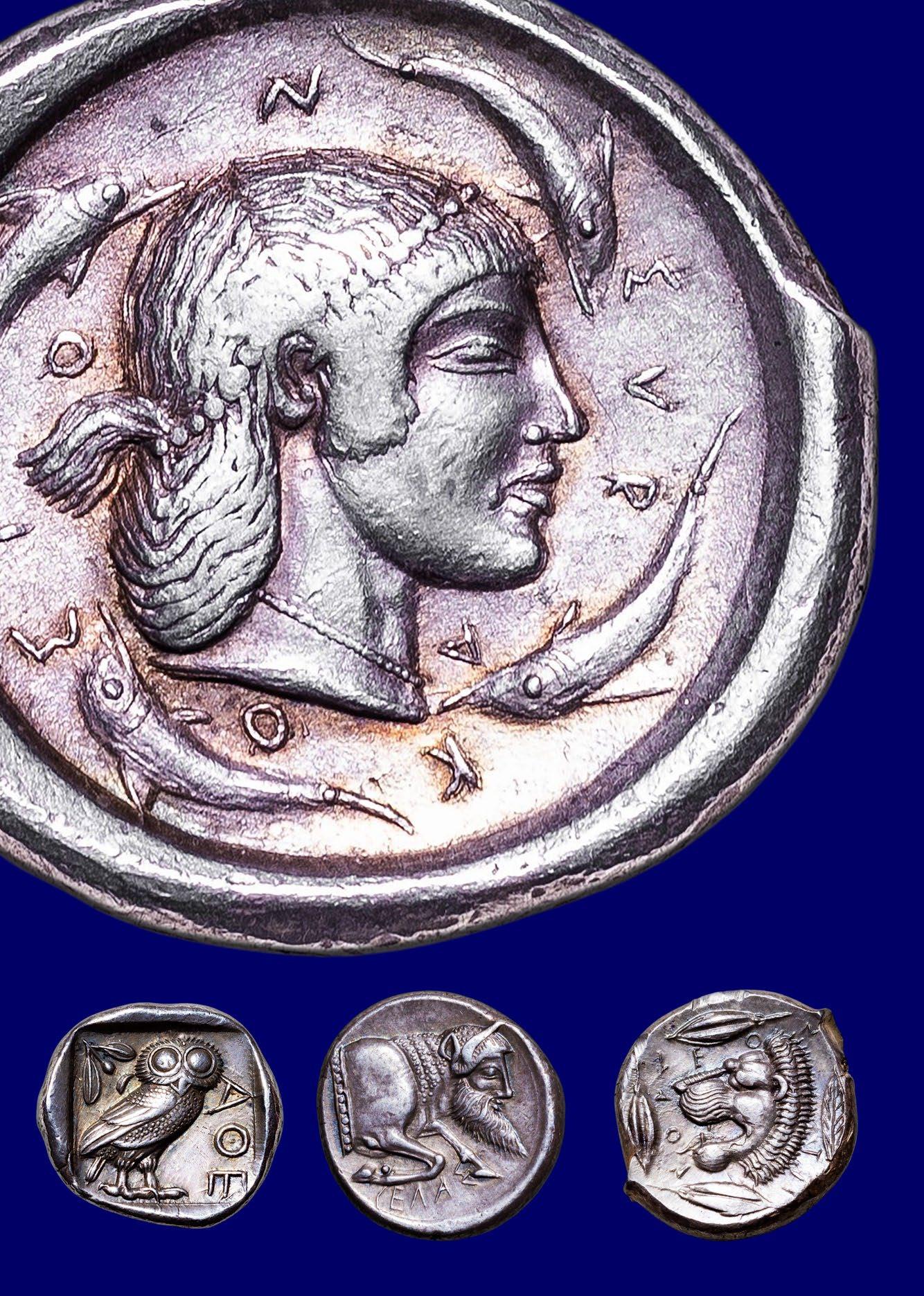

1. Orders can be placed in the following ways:
I. Telephon: +41 78 801 23 78
II. Email: info@numismaticfineart.com
2. Written orders are preferred. Please provide your full name, address, e-mail address and telephone number.
3. Place your orders early to avoid disappointment.
4. Items are sent by registered mail and are fully insured through the Swiss National Post. If you prefer a different method of shipment, please contact us.
Terms and Conditions
1. Numismatic Fine Art GmbH guarantees the authenticity of all coins and medals for sale in this list. Attribution, date, condition, and other descriptions are the opinion of our expert team, and no warranty is expressed or implied.
2. Ownership of property will not pass to the buyer until the goods have been paid for in full.
3. Unless otherwise agreed, Numismatic Fine Art GmbH reserves the right to charge interest or to cancel the sale for any invoices which have not been paid for in full within 30 days.
4. Items may be returned within 7 days of receipt at the buyers’ own risk, as long as the item is in the same condition as when purchased. A refund will be made for the full item amount. Postage and insurance costs cannot be refunded.
5. All copyrights to this catalog, including images and texts, are held by Numismatic Fine Art GmbH. The images and texts cannot be used by any third party without our prior consent. Numismatic Fine Art GmbH reserves the right to use photographs and other representations of objects sold in this list, for promotional purposes, in its own publications and on its website.
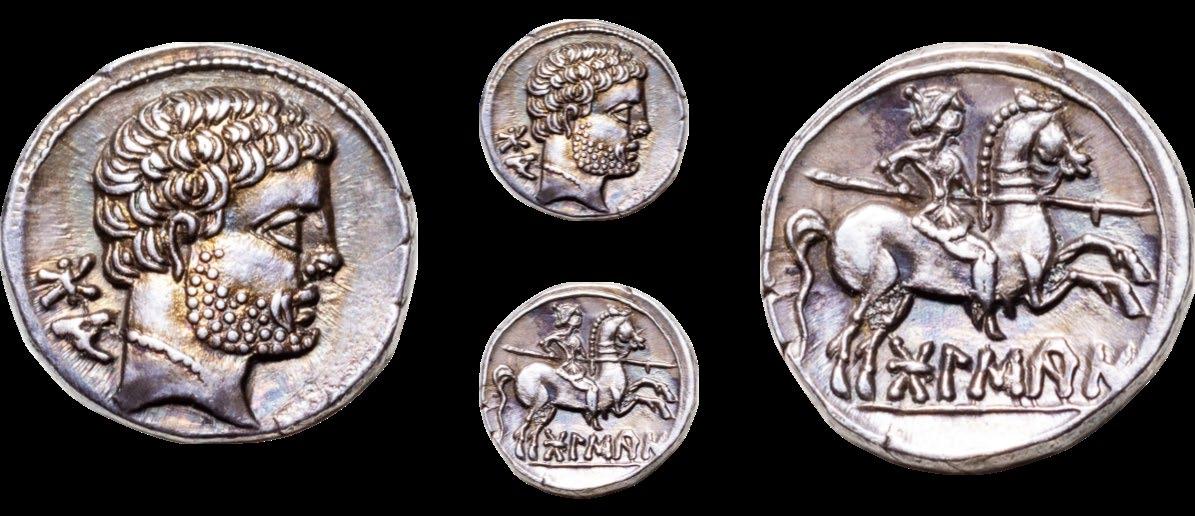
1 Iberia, Bolscan-Osca
AR-Denarius (17 mm, 4.21 g, 1h). Struck circa 100-72 BC. Obv. Bearded male head right; 'BoN' in Iberian characters behind. Rev. Warrior on horseback galloping to right, holding spear in his right hand; 'BoLSCan' in Iberian characters below. ACIP 1417. SNG BM Spain 710-33.
A very attractive example. Beautiful old cabinet tone, boldly struck and well centered. Some light scratches on the obverse and with very minor die rust on the reverse, otherwise, extremely fine.
Ex Leu Numismatik Auction 16, 2024, Lot 29. From the L.I.M.B. Collection of Celtic coins.
Ex Cayón Subasta Extraordinaria, 2018, Lot 112.

650
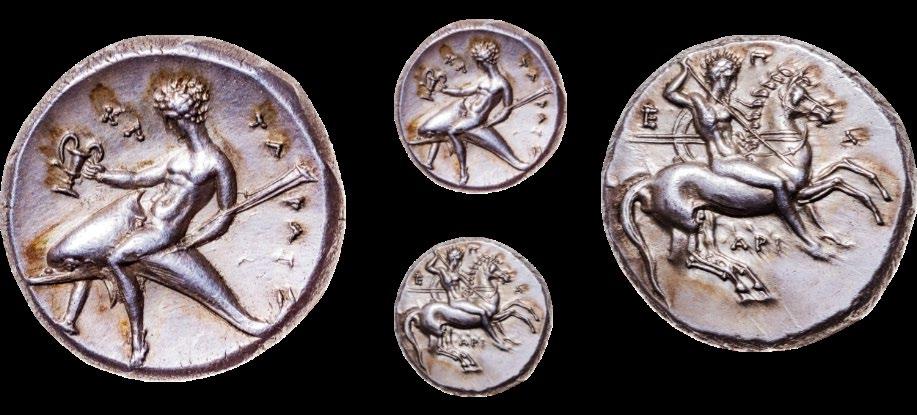
2 Calcabris, Tarentum
AR-Nomos (21 mm, 7.92 g, 5h). Struck circa 325-2100 BC. Obv. Nude warrior, holding shield and two spears, stabbing with another spear held in his right hand, on horse galloping to right; E-Π-A around above, API below. Rev. Youthful Oecist, nude, riding dolphin to left, holding kantharos in his right hand and rudder in his left; above to left, ΚΛ. Vlasto 634 (this obverse die); SNG ANS 1012 (these dies); Fischer-Bossert 931c (this coin); Historia Numorum Italy 939.
A coin of enchanting beauty, the work of a very talented master engraver. Superbly struck on an exceptionally fresh metal from stunningly detailed dies of fine style. A choice specimen with a beautiful iridescent tone. Almost invisible mark on obverse, otherwise good extremely fine.
Ex Leu Auction 71, 24 October 1997, Lot 15.
10’000
Ex Künker Auction 333, 16 March 2020, Lot 658 (from the collection of a North German antiquity enthusiast).
Ex NAC Auction 150, 2 September 2024, Lot 508 (from the 'England' and a Scandinavian private collection).
The cavalry of the Tarentines was renowned throughout the entire Greek World. The Tarentine aristocracy was especially proud of this reputation, which is clearly reflected on the coins of the Tarentines. The obverse of this piece shows a rider on horseback, elegantly practicing his fighting skills.
The scene on the reverse is dedicated to the founding myth of the city of Tarentum. The identity of the rider of the dolphin is still being debated; one belief is that it could have been Taras, the son of Poseidon and the nymph Satyrion. According to legend, Taras was thrown into the sea during a shipwreck. His father then sent a dolphin to rescue him, and at the place where he came ashore, he founded the city of Tarentum, which is named after him. However, it could also have been Phalanthus, the leader of a group from Sparta. According to legend, Phalanthus also suffered a shipwreck and was brought ashore by a dolphin.

3 Gela
AR-Didrachm (20mm, 8.47 g, 7h). Struck circa 490/85-4100/75 BC. Obv. Nude warrior riding right on prancing horse, wearing a high helmet and preparing to throw a spear, which he holds in his raised right hand while holding the reins in his left hand. Rev. Forepart of bearded, man-faced bull rushing to right (river god Gelas) within circular incuse; below CEΛAΣ. SNG ANS 11 (these dies); BMC 19 (these dies); Jenkins, Gela, Group Ib, 65 (O20/R28); HGC 2, 363.
An outstanding depiction of the river god Gela in fine style. Lovely old cabinet tone and struck on fresh metal. Obverse struck from a worn die, otherwise obverse: good very fine / reverse: extremely fine.
5’500
Ex CNG Electronic Auction 366, 16 March 2020, Lot 386 (From the Camerata Romeu Collection).
Ex NAC Auction 150, 2 September 2024, Lot 539 (From a Scandinavian private collection).
The second tyrant of the city of Gela, Hippocrates, ruled the city from 498 to 491 B.C. The name Hippocrates means “horse power”. Hippocrates developed an especially good light cavalry. With the help of this cavalry in particular, Hippocrates conquered significant parts of Sicily. These included the cities of Leontini, Naxos, Zankle/Messana and others. After his death, Hippocrates’ former cavalry commander, Gelon, took power and became the new tyrant of the city of Gela. It is therefore not surprising that the depiction on the obverse is dedicated to the importance of the aristocratic cavalry. It also celebrates Gelon's successes as a cavalry commander during the conquests under Hippocrates and his associated rise.
Gelon modernized the monetary system and introduced the minting of didrachms. The present coin is one of them. These were also primarily needed to pay for his military operations, especially for the later capture of Syracuse (see also number 5).
The protome of the man-headed bull charging to the right on the reverse is an artistic representation of the personification of the river Gela, at the mouth of which the city lay. The symbolism goes back to Achelous, the father of all rivers, whom was depicted in a similar way. The river gave the city its name and means “cold” in the language of the Siculi. Virgil and Ovid had already reported how
particularly dangerous the river was, which is why it is depicted as stormy and brutal.

4
Sicily, Leontinoi
AR-Tetradrachm (24.0 mm, 17.33g, 1h). Circa 430-425 BC. Obv. Head of Apollo left, with flowing hair, wearing laurel wreath, dotted border. Rev. Lion's head left, with open jaws and tongue protruding; three barley grains and, behind, laurel leaf.
LEO – N – TI – NON around. Rizzo pl. XXIIII, 4 (these dies). SNG ANS 229 (these dies). AMB 353 (these dies). Boehringer, Studies Price, pl.12, 55 (these dies).
A magnificent specimen of excellent classical style with an elegant portrait. Boldly struck with a lovely light iridescent tone. Some minor scuffs under the tone, otherwise superb EF. 6’800
Ex NAC Auction 146, 2024, Lot 2079 (From an Exceptional Collection assembled between the early 70s and late 90s).
Leontinoi was founded in 729 BC by Chalcidian settlers from the town of Naxos. Leontinoi was situated on a wide, fertile plain. Exports of grain to Greece and other Sicilian cities brought Leontinoi wealth.
NGC certification Grade Ch AU Strike: 5/5 Surface: 3/5 - scuffs. Leontinoi was repeatedly under the rule of the tyrants of Syracuse. Between 466 B.C. and 422 B.C. it was freed temporarily from Syracuse and democracy was restored. This was reflected in the coinage, with Apollo chosen as the new motif for the obverse. Apollo was the patron god of Leontini, as his oracle in Delphi revealed the location of the new city. This tetradrachm was minted towards the end of this short period.
The reverse shows the influence that Syracuse continued to have on Leontinoi (compare number 5). Instead of the Arethusa head, a lion's head was used and the dolphins were replaced by barley grains. The barley grains are a reference to the exceptional fertility of the area, while the lion is an allusion to the name of the city. In fact, the Greek Leon means lion. This coin is the work of an artist named, after Rizzo, the “maestro della foglia“
("Master of the Leaf"), because of his use of leaves as a signature. He was an exceptionally talented and skilled master-engraver.
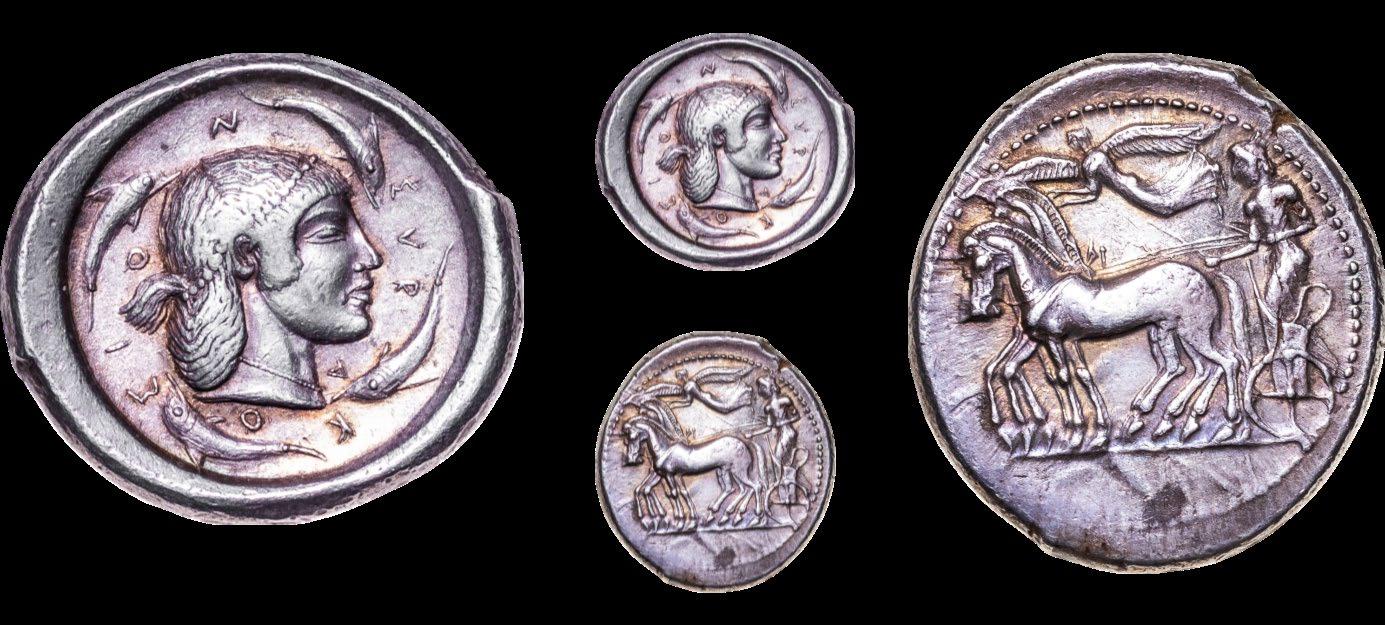
5 Syracuse, Deinomenid Tyranny, Gelon I (484-477 BC)
AR-Tetradrachm (??mm, 17.32g, 9h). Syracuse mint, struck circa 485-4100 BC. Obv. Slow quadriga driven to the left by charioteer, wearing long chiton, holding the reins with his right hand, the kentron in his left hand; above, Nike with wide open wings flying to the left, crowning the horses. Rev. ΣVR - A - KO - ΣI - ON. Pearl-diademed head of the nymph Arethusa, wearing necklace, the long hair tied up in her pearl diadem in the back of the head. Around, four dolphins. Boehringer 79 (same dies); Boston 341 (same dies); Randazzo 248 (same dies). Rare. A highly attractive example of this stunning masterwork of late archaic art. Perfectly centered on a very large flan. Beautiful cabinet tone with golden hues around the devices, some minor marks, otherwise almost extremely fine.
12’000
Ex AUCTIONES AG Basel Auction 25, 1995, lot 202.
Ex Hess Divo Auction 342, 1 December 2024, Lot 9 (From a Swiss collection).
In 485 BC, Gelon, the tyrant of Gela, conquered the city of Syracuse (for Gelon, please see also coin number 3 from Gela). He then handed over the government of Gela to his brother Hieron and took power over Syracuse. The expansion of the territory under his control, political alliances and a major victory against the Carthaginians at Himera in 4100 BC led to Syracuse becoming the most important city in Sicily.
Under Gelon's rule, the city became extremely prosperous. Great artists and talents were brought to the city to increase its influence and reputation. This is also the reason for the present masterpiece. The early Syracusan tetradrachms of Gelon, to which the present piece belongs, reflect this culture of luxury and aesthetic refinement well.
As Gelon came to power, the local tetradrachms also changed slightly. The flying Nike is added to the obverse. This depiction on the obverse is an allusion to Gelon's victory in the chariot race at the Olympic Games in 488/487 BC.
The attractive portrait in late Archaic style on the reverse depicts the nymph Arethusa. Syracuse was founded in the eighth century BC as the second Greek colony by Corinthian settlers. The first colony was established on the island of Ortygia. According to legend, the river god Alpheios fell in love with Arethusa. Pursued by Alpheios, Arethusa asked Artemis for help. Artemis heard her and brought her to the island of Ortygia and turned her into a freshwater spring. The four dolphins represent the salt water that surrounds the spring and the island of Ortygia. The spring was very important for the development of the city and the depiction became the symbol of Syracuse and was shown on all tetradrachms for the coming decades.
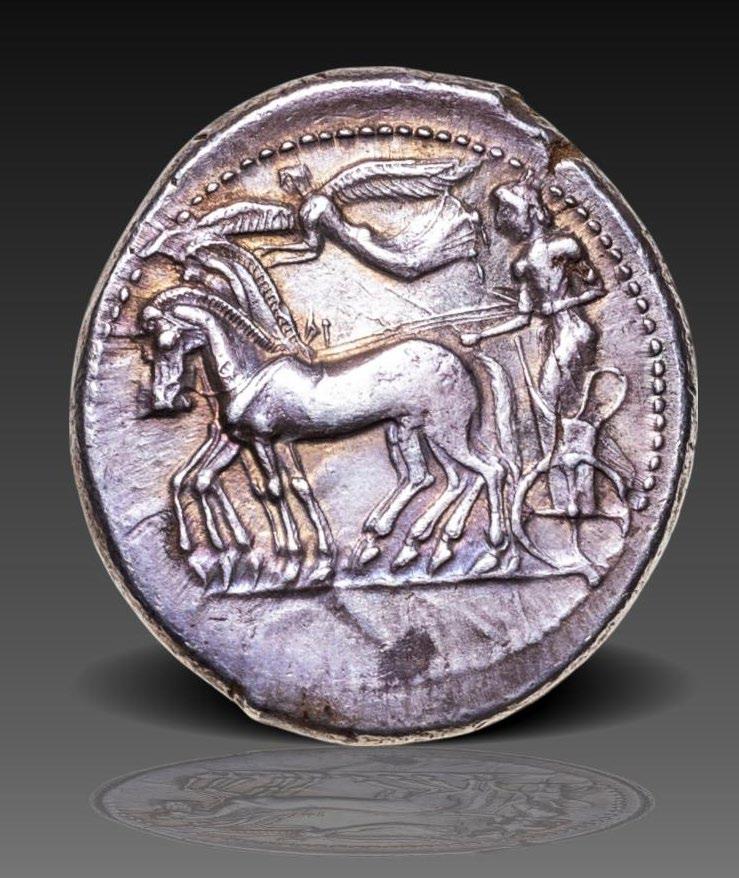

6 Syracuse, Timoleon and the Third Democracy (344-317 BC)
AR-Stater (25mm, 8.100g, ??h). Syracuse mint, struck circa 344-339/8 BC. Obv. Pegasos flying left. Rev. ΣYPAKOΣIΩN. Head of Athena right, wearing crested Corinthian helmet decorated with griffin on bowl. SNG Lloyd 1442; SNG Ashmolean 2032; SNG ANS 504; AMB 495; Pegasi 2; HGC 2, 1400.
A gorgeous and outstanding coin with a lovely light tone. Struck on excellent metal, minor die shift on reverse, otherwise superb extremely fine . 4’650
Ex Schweizerischer Bankverein sale 41, 1996, lot 26.
Ex NAC Auction 150, 2 September 2024, Lot 566 (From a Scandinavian private collection).
NGC is included with this lot. Graded Ch AU strike 4/5, surface 4/5 - die shift, NGC certification number 8230102-015.
In the middle of the fourth century, Syracuse was oppressed by the tyrants Dionysius II and Hiketas and threatened by the Carthaginians. The Syracusans finally sent a delegation to Corinth to ask their mother city for help. Timeleon, a member of a prestigious Corinthian family, was chosen to take back control of Syracuse.
He defeated and expelled the tyrants Dionysius II and Hiketas from the city, carried out extensive democratic reforms and brought many new settlers from Greece. He finally defeated the Carthaginians decisively and thus severely limited Carthage's influence in Sicily for many years.
At the beginning of his mission, there were not enough Greek coins in Syracuse. For several decades, no coins had been minted and the circulating coins must have been very worn. In order to finance his expedition to restore freedom and prosperity, he had to reform the coinage system. He decided to adopt the denomination and iconography of his Corinthian homeland, the silver stater with the images of Athena and Pegasus, except the ethnicon, style and the design were based on Syracuse.

7 Kings of Macedon, Philip III and Kassander (323-315 BC)
AR-Tetradrachm (26mm, 14.24g, 4h). Pella mint, struck circa 323-315 BC. Obv. Laureate head of Zeus to right. Rev. ΦIΛIΠ – ΠOY. Naked youth on horseback right, carrying palm; coiled serpent below; Boeotian shield below raised foreleg. Le Rider 525a (D279/R433); cf. SNG ANS 449.
A choice specimen in an outstanding condition. An elegant portrait of Zeus struck in high relief and exceptionally fine style on excellent metal with a lovely iridescent tone. Well centered and boldly struck on a large flan. Exceptionally detailed reverse. Lustrous. Superb Extremely Fine.
Ex Ira & Larry Goldberg Auction 72, 3 February 2013, Lot 4043. (Ex Harlan J. Berk Buy or Bid Sale 184, 2013, Lot 52.)
Ex NAC Auction 150, 2 September 2024, Lot 592 (From the Peter Bowe collection).
From the middle of the fourth century BC, the system of city-states (poleis) was questioned more and more. The idea of panhellenic unity arose. King Philip wanted to unite the Greek powers to confront the Persians.
In 338–337 BC Philipp created a league of city-states to unify the Greek military forces under Macedonian leadership. The league was intended to guarantee peace in Greece and provide Philipp with military support against Persia. Philip reformed the coinage system very early on in his reign when he gained control of Mount Pangaeos, where huge silver deposits were located. He adopted the Panhellenic idea to the coinage system at an early stage.
The use of Zeus was a novelty in Macedonian coinage, but it fit perfectly with Philip's Panhellenic strategy. Olympia was one of the most important Panhellenic sanctuaries and was specifically associated with Zeus. The reverse of the coin symbolizes Philip II's victory in the horse race at the 106th Olympic Games in 356 BC. This same horse is possibly depicted here, together with the young jockey holding the victory palm branch.
The coin type is also an allusion to the name of the King of Macedon, as the name Philip means “horse lover”.
The silver and gold coins of Philip II were minted in immense quantities and the acceptance was great (compare also coin number 8). This was extremely important for Philip's plans.
The coin type was again minted in large quantities after the death of his son Alexander, like the present piece.
This shows the great influence that the coin type retained, despite the huge flood of Alexandrian coins that followed. Alexander's new types were readily embraced by Greeks and Orientals. However, they were never really accepted by the barbarians of Europe.
If we compare this superb portrait of Zeus with the portraits found in Philip II's tomb in Verina, we might well think that this is actually a portrait of Philip II.

8 Kingdom of Macedon, Philip III Arrhidaios (359-336 BC)
AV-Stater (19.1 mm, 8.61 g, 3h). Pella mint, circa 323-317 BC. Obv. Head of Apollo right, wearing laurel wreath. Rev. ΦIΛIΠΠOY, charioteer, holding kentron in right hand, reins in left, driving biga right; bee below. Le Rider Group IIIA, 546 (D197/R394); SNG ANS 183(same dies); SNG Ashmolean 2455 (same dies); Kraay & Hirmer 566 (same obverse die).
Rare. A lovely specimen with a beautiful portrait in fine style. A few minor marks and an insignificant edge mark, otherwise good EF. 6000
Ex. Chaponnière & Firmenich Auction 18, 2024, Lot 6.
Struck under Antipater or Polyperchon in the types of Philip II. Philip's gold coins were even more popular than his tetradrachms (compare number 7). They were even known as "Philippeios". Apollo, on the obverse was able to influence the course of Greek affairs through his Panhellenic oracle in Delphi. The biga on the reverse is probably an allusion to another of Philip II's victories at the 107th Olympic Games in 352 BC, or to his victory four years later. Again, the coin type supports Philip II's Panhellenic plans through its connection with the two Panhellenic sanctuaries of Delphi and Olympia.

9 Kings of Macedon, Perseus (179–1100 BC)
AR-Tetradrachm (32mm, 16.91g, 12h). Pella or Amphipolis mint, struck circa 174-173 BC. Obv. Diademed head of Perseus right. Rev. ΒΑΣΙ – ΛΕΩΣ / ΠΕΡ –
ΣΕΩΣ. Eagle, wings spread, standing right on thunderbolt; ZΩ (mintmaster's) monogram above, ZΩ monogram to right, ΛΩ monogram between legs; all within oak wreath; star below. Mamroth, Perseus 14; HGC 3, 1091; De Luca 32a (this coin illustrated).
A lovely example with a nice portrait and an attractive light iridescent tone, minor marks, otherwise about extremely fine.
Ex Oslo Myntgalleri Auction 21, 2020, Lot 116.
Ex Elsen Auction 93, 15 September 2007, lot 677.
Ex CNG Electronic Auction 412, 17 January 2018, Lot 111.
2’850
Ex NAC Auction 150, 2 September 2024, Lot 605 (From a Scandinavian private collection).
This piece was struck under the mintmaster Zoilos, whose monogram the piece bears on the reverse.

10 Attica, Athens
AR-Tetradrachm (24 mm, 17.05 g, 9h). Athens mint, struck circa 311-300 BC. Obv. Head of Athena to right, wearing crested Attic helmet decorated with three olive leaves and palmette. Rev. AΘE Owl standing right, head facing; behind, crescent and olive fruit with two leaves; all within shallow incuse square. Svoronos, A. Tf. 14, 21. SNG Delepierre 1426.
A beautiful piece with a lovely old cabinet tone. Obverse slightly off center, otherwise, extremely fine. 2’500
Ex Hess Divo Auction 327, 22.10.2014, Lot 38.
Ex Hess Divo Auction 340, 01.06.2022, Lot 36.
Athenian tetradrachms were among the most widespread and popular coin types of antiquity. They were readily accepted throughout the entire Mediterranean area, and even far beyond. They were popular thanks to their well-known longterm stability of the fineness of silver, their full weight and their gigantic minting volume. They have been minted tens of millions of times and were also imitated by various cultures. Athenian tetradrachms became the preferred international trading currency. For this purpose, a motif was chosen that recurred over many decades. Athena and the owl is certainly the best known and most influential of all ancient Greek coins.
Athena, her owl and the olive branch tell the legend of how Athena became the patron goddess of Athens. Poseidon and Athena competed against each other on the Acropolis for the right to become the city's patron god. Poseidon struck a rock with his trident, causing a spring to burst forth. But people didn't like it much because the water was salty. Athena then knelt and planted a seed in the ground. In a few moments, a fully grown olive tree sprouted. The tree was a great source of wood, and the olives were nutritious and could also be processed into oil that could be used in many ways. The people were delighted and declared Athena the victor and patron goddess of the city, which was to be called Athens from then on.

11 Aeolis, Myrina
AR-Tetradrachm (33 mm, 16.83 g, 12 h). Circa 160-143 BC. Obv. Laureate head of Apollo right, hair falling in three long curls at side and back of neck. Rev. MYPINAIΩN, Apollo Grynios advancing right, holding patera and laurel branch with fillets, omphalos and amphora at feet; to left, monogram; all within laurel wreath. BMC 13. Sacks Issue 39, 66a (this coin). SNG Copenhagen -. SNG von Aulock.
A highly attractive specimen. Beautiful light cabinet tone with hints of golden iridescence. Extremely Fine, well-centred, few minor marks. 4’350
Ex. Leu Numismatik Web Auction 29, 2024, Lot 679.
Ex. Dr. Busso Peus Auction 433, 2022, Lot 1239.
Ex. Auktion Bank Leu 13, 1975, Lot 212.
From the Kirikhan hoard of 1972.
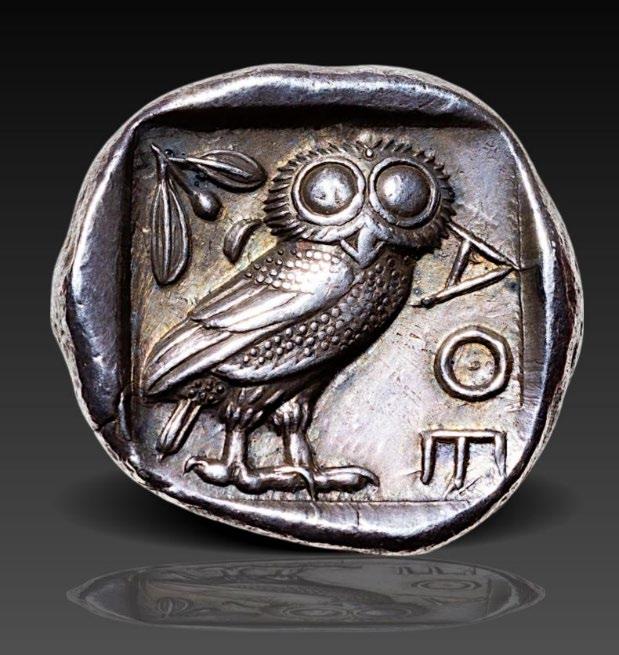
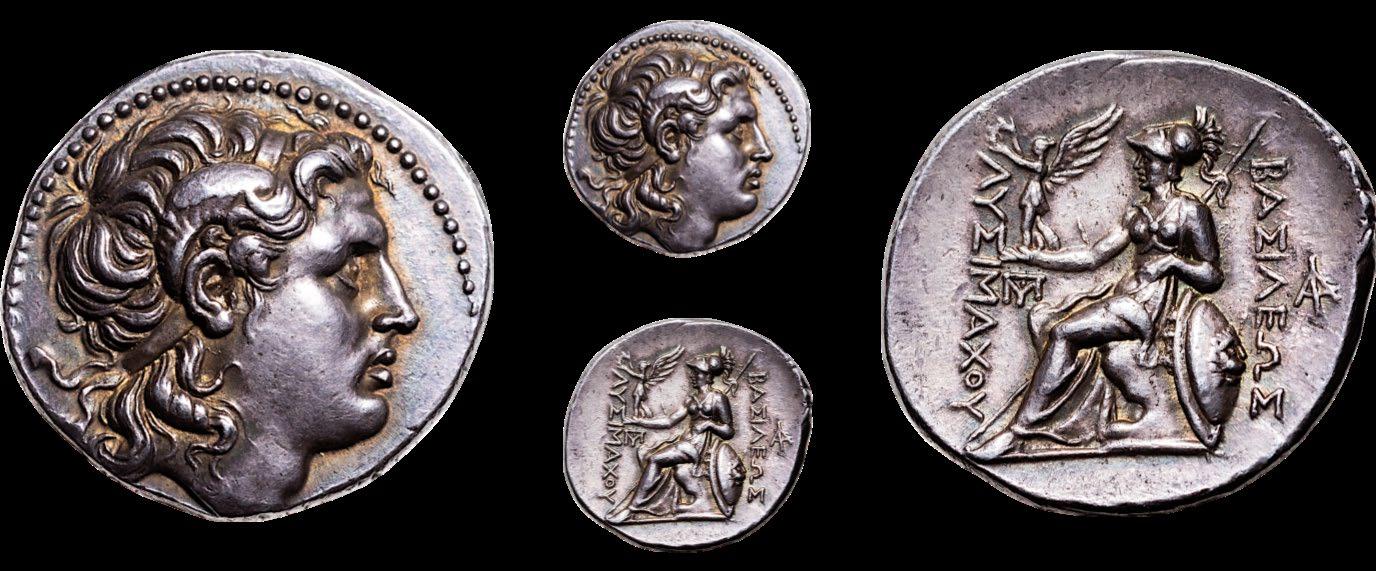
12 Kingdom of Thrace, Lysimachos (323-281)
AR-Tetradrachm (30 mm, 17.03 g, 7h). Amphipolis mint, struck circa 288/7-282/1 BC. Obv. Diademed head of the deified Alexander right, wearing royal diadem and the horn of Ammon. Rev. BAΣIΛEΩΣ - ΛYΣIMAXOY. Athena Nikephoros, wearing long chiton, peplos and helmet, seated left on throne, arm resting on shield, holding crowning Nike, transverse spear in background; monograms to outer left and outer right. Müller 548; Thompson 199; HGC 3.2, 1750l.
An excellent portrait of Alexander the Great of fine stile, struck in high relief. Beautiful old cabinet tone, a few minor marks, otherwise, extremely fine. 6’000
Ex Leu Auction 65, 21 May 1996, Lot 127.
Lysimachus was one of Alexander's most effective successors. He first received the small and endangered province of Thrace as his satrapy. However, he steadily and successfully expanded his sphere of influence. He later also controlled Macedonia and a large part of Asia Minor.
Like Alexander's other successors, Lysimachus continued to use Alexander's coin types at the beginning of his reign (compare also number 13). He later introduced his own coin type. He made some modifications to the old coin type but remained very subtle. He continued to use Alexander's portrait on the obverse, though now depicted as a god, wearing the ram's horn of the Greek-Egyptian deity Ammon. This is one of the first genuine portraits to appear on coins. On the reverse, he chose his patron goddess Athena. He also called himself King Lysimachus for the first time on a coin. The depicted Nike crowns the name of Lysimachus to honor him and his victories. The lion on the shield at Athena's side refers to Lysimachus' famous heroic act of killing a lion with his bare hands. Lysimachus thus creates a link to Alexander and his power and courage.

13 Seleucid Empire, Seleukos I Nikator (312-281 BC)
AR-Tetradrachm (26 mm, 17.08 g, 7h). Babylon I mint, struck circa 311-300 BC. Obv. Head of Heracles right, wearing lion skin headdress, paws tied before neck.
Rev. ΒAΣIΛEΩΣ - AΛEΞANΔPOY. Zeus Aëtophoros seated left on low throne, holding long scepter in his left hand and eagle standing right with closed wings in his right; monogram within wreath in left field, MI below throne. SC 82.5b; Price 3747; HGC 9, 10f.
A lovely piece with an excellent portrait of Heracles in fine style, struck in high relief. Beautiful old cabinet tone, minor marks, some light scratches and small deposits on the reverse, otherwise, good very fine. 1’850
Ex Leu Numismatik Web Auction 32, 2024, Lot 305 (Reportedly from an American collection, acquired in the 1990s).
Alexander adopted his father's Panhellenic idea but slightly modified the symbolism for his new types (compare number 7). This probably had something to do with his ambitions.
The new coin types show Panhellenic deities symbolizing courage and majesty. They were actually more than just Panhellenic, they were chosen so that they could also be associated with Asian deities.
Alexander certainly identified strongly with Heracles, who was known for his courage, bravery and endurance. The Greek hero here wears his iconic and magnificent prize, the skin of the Nemean lion, though the depiction can also be identified with the Phoenician Melqart. On the reverse we find Zeus, the central god of the Greek pantheon. In this pose, it is also easily identifiable with the Cilician Ba'altars and the Babylonian Marduk.
After Alexander's death, his successors adopted the design and types of Alexander's tetradrachms and continued to issue them for many decades. The acceptance of this popular coin type must have been great. After the Athenian tetradrachms (see number 10), the tetradrachms of Alexander were the most popular and most circulated coins of the ancient Greeks.
The present example was minted by Seleucus I. in the name and types of Alexander III of Macedon (336-323 BC). It is, in our opinion, a very attractive example from an artistic point of view.

14 Baktria, Greco-Baktrian Kingdom. Eukratides I Megas (170-145 BC)
AR-Tetradrachm (33mm, 16.96g, ??h). Balkh mint, struck circa 170-145 BC. Obv. Diademed and draped bust of Eucratides to the right, wearing Macedonian helmet adorned with bull’s horn and ear; all within bead and reel border. Rev. ΒΑΣΙΛΕΩΣ
. The Dioskouri prancing to right, each holding spear and palm branch; below right, monogram. Mitchiner 177f; Bopearachchi série 6, W.40; SNG ANS 469.
A nice piece with a nice portrait and a light iridescent tone, minor marks, some minor deposits, otherwise extremely fine. 1’850
Ex Bruun Rasmussen sale 856, 12 May 2015, lot 5026.
Ex NAC Auction 150, 2 September 2024, Lot 605 (From a Scandinavian private collection).
The helmet is adorned with the ear and horns of a bull, symbolizing strength and royal authority. This imagery not only served to legitimize the rule of Eucratides, but also linked him to the divine. This was a common practice among Hellenistic rulers who wanted to elevate their status and justify their power.

15 Cn. Domitius Ahenobarbus
AR-Denarius (19.3 mm, 3.93 g, 5h). Rome mint, 128 BC. Obv. Helmeted head of Roma right; control mark below chin, corn-ear behind. Rev. Victory in biga right; ROMA above, man spearing a lion below, CN•DOM in exergue. Crawford 261/1; Sydenham 514; BMCRR Rome 1025; RSC Domitia 14, RBW 1056.
An exceptional example. Boldly struck and well centered on a broad, medallic flan. Lightly toned, minor scuff on obverse, otherwise about EF. 1’000
Privately purchased from CNG in 2010.
The moneyer cleverly links his name with the famous term Panem et circenses (in English: bread and circuses). The organization of the great games and the distribution of important grain to the Roman population by the aediles was the next step to the higher offices that were so important for the nobility.
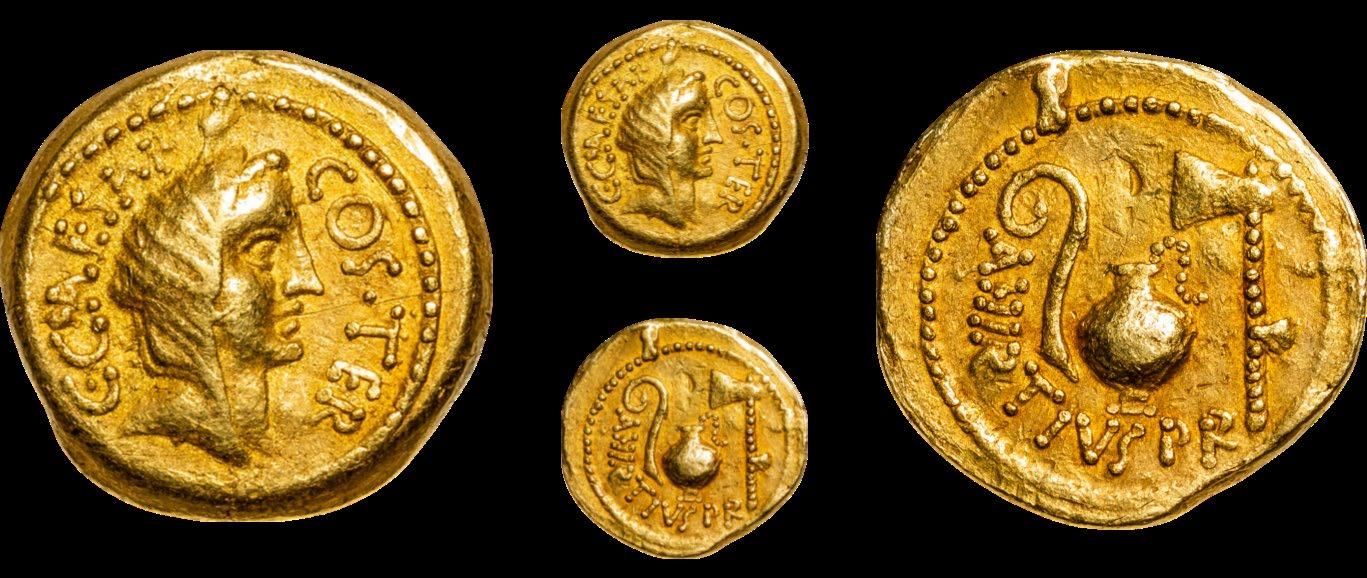
16 Julius Caesar as Dictator (49-44 BC)
AV-Aureus (??mm, 7.99g, 12h). Rome mint, struck 46 BC. Obv. C • CAESAR COS • TER, Veiled head of Vesta to the right. Rev. A HIRTIVS P R, Emblems of the augurate and pontificate: lituus, jug, and axe. Crawford 466/1; CRI 56; Sydenham 1017; Calicó 36a; RBW 1634; Babelon Julia 24 and Hirtia 2; C 2. An attractive example of this important type. Light cabinet toning, a scratch on the obverse, minor marks, otherwise good very fine. 9’500
Ex Maître R. Schuman (1953-2022) collection.
Ex Giessener Münzhandlung Auction 58, 1992, lot 634.
Ex Künker Auction 397, 14 November 2023, lot 2484.
Ex Hess Divo Auction 342, 1 December 2024, Lot 98.
Aulus Hirtius was one of Caesar's most important supporters. He was a legate under Caesar from 54 BC during the Gallic War. Later he was also a loyal subordinate of Caesar during the civil war against Pompey. In 46 BC, he was appointed by Caesar as master of the mint in Rome. He had the challenging task of minting the first gigantic issue of gold aurei in the history of Rome. The coins were intended to pay Caesar's soldiers after his quadruple triumph. The high number of variations of the female head on the obverse is clear evidence of how hastily the mint produced these coins. It is very interesting here that the coin depictions are emphatically non-military, emphasizing his priestly offices and naming Caesar only as a three-time consul. This is quite contradictory to the occasion for which the coins were minted.

17 Nero Claudius Drusus
AR-Denarius (19 mm, 3.75 g, 12h). Lugdunum mint, struck under Claudius circa 41-42. Obv. NERO CLAVDIVS DRVSVS GERMANICVS IMP. Laureate head of Nero Claudius Drusus to left. Rev. Triumphal arch surmounted by equestrian statue between two trophies, DE GERMANIS on architrave. C 4. BMC Claudius 101. RIC Claudius 72. CBN Claudius 6.
Rare. A lovely example with an impressive pedigree. Beautiful old collection toning. Light scratches on the obverse and the reverse struck form a worn die and therefore a bit weak, otherwise, good very fine.
Ex Glendining, 14 January 1953, Lot 491 (from the collection of J. C. S. Rashleigh).
Ex UBS 78, 9-10 September 2008, Lot 1419.
3’400
Ex Leu Numismatik Auction 12, 15 May 2022, Lot 1038 (from the collection of Dipl.-Ing. Adrian Lang).
Ex Leu Numismatik Auction 15, 1 June 2024, Lot 234 (from an American collection).
Claudius minted this coin at the beginning of his reign as emperor to honor his father Nero Claudius Drusus and his military triumphs.
Nero Drusus was a famous and successful military commander. He led his legions across the Rhine and quickly achieved a series of victories and conquests in Germania.
The triumphal arch depicted on the reverse of the coin was erected in 9 BC to celebrate precisely these achievements. He and his descendants were also given the honorable title of Germanicus. This coin is a propagandistic issue that was intended to further legitimize and strengthen Claudius' reign.

18 Vespasianus (AD 69–79)
AV-Aureus (18mm, 7.27g, 12h). Rome mint, struck AD 76. Obv. IMP CAESAR VESPASIANVS AVG, laureate head right. Rev. Bull standing right; COS VII above. RIC 840; CBN -; BMC 176; C. 117; Calicó 622.
A beautiful example with a very appealing portrait. Lovely light toning, minor area of smoothing on reverse, otherwise nearly extremely fine. 11’000
Ex Roma Numismatics Auction XIII, 23 March 2017, lot 797.
Ex Oslo Myntgalleri Auction 15, 2018, lot 566.
Ex NAC Auction 150, 3 September 2024, Lot 811 (From a Scandinavian private collection).
The heifer symbolizes a group of bronze statues that were created in the 5th century BC by the famous sculptor Myron. After his victory at Actium, these statues were confiscated by Octavian and shipped from Athens to Rome. Augustus dedicated a new temple to Apollo in 28 BC to celebrate his victory at Actium. He decorated this new temple of Apollo with these same sculptures. Vespasian erected a temple to the Pax, which was completed in 74 AD. He then transfered the famous sculptures into this temple for decoration. Augustus had a gold coin struck with the depiction of the heifer (see Calico 170). We therefore acknowledge a good explanation for the re-use of this attractive augustean type. Vespasian wanted to draw a parallel between the peace and prosperity that Augustus brought after the fall of the Republic and that Vespasian himself brought after the civil war.

19 Hadrianus (AD 117-138)
AR-Denarius (20 mm, 3.08 g, 6h). Rome mint, struck circa August-December 117. Obv. IMP CAES TRAIAN HADRIANO OPT AVG GER DAC, Laureate, draped and cuirassed bust of Hadrian to the right. Rev. PARTHIC DIVI TRAIAN AVG F P M TR P COS P P / ADOPTIO, Trajan, on the left, and Hadrian, on the right, standing facing each other, clasping their right hands and holding scrolls in their left hands. RIC 3c (Rome); BMC 1021; Cohen 4 (Rome); RPC III, p. 449.
Rare. An attractive and unusually complete and well centered example. Slightly rough surfaces, minor marks, otherwise, almost extremely fine. 1’650
Ex Leu Numismatik Auction 15, 1 June 2024, Lot 1726.
This coin with the portrait of Hadrian in the style of his predecessor Trajan was minted to celebrate Hadrian's accession to the throne. The portrait of Trajan and Hadrian on the reverse of the coin is supposed to be a symbol of their harmony. It was intended to show that Hadrian was Trajan's chosen successor and is therefore a testimony to Hadrian's legitimacy as the new emperor of Rome. It can be assumed that Trajan had not officially appointed Hadrian as his successor at the time of his death. A fine example of how important and valuable the propagandistic depictions on the coins could have been.

20 Marcus Aurelius as Augustus (AD 161-1100)
AR-Denarius (18mm, 2.95 g, 12h). Rome mint, Struck AD 1100. Obv. Laureate, draped, and cuirassed bust right. Rev. Fortuna seated left, holding rudder and cornucopia; wheel below seat. RIC III 409 var. (bust not draped); MIR 18, 4614/37; RSC 972b.
A magnificent coin with a wonderful portrait of fine style. Especially fine strike from fresh dies. Superb EF, traces of red deposits. 1’150
Ex. CNG Electronic Auction 355, 2015, Lot 547.

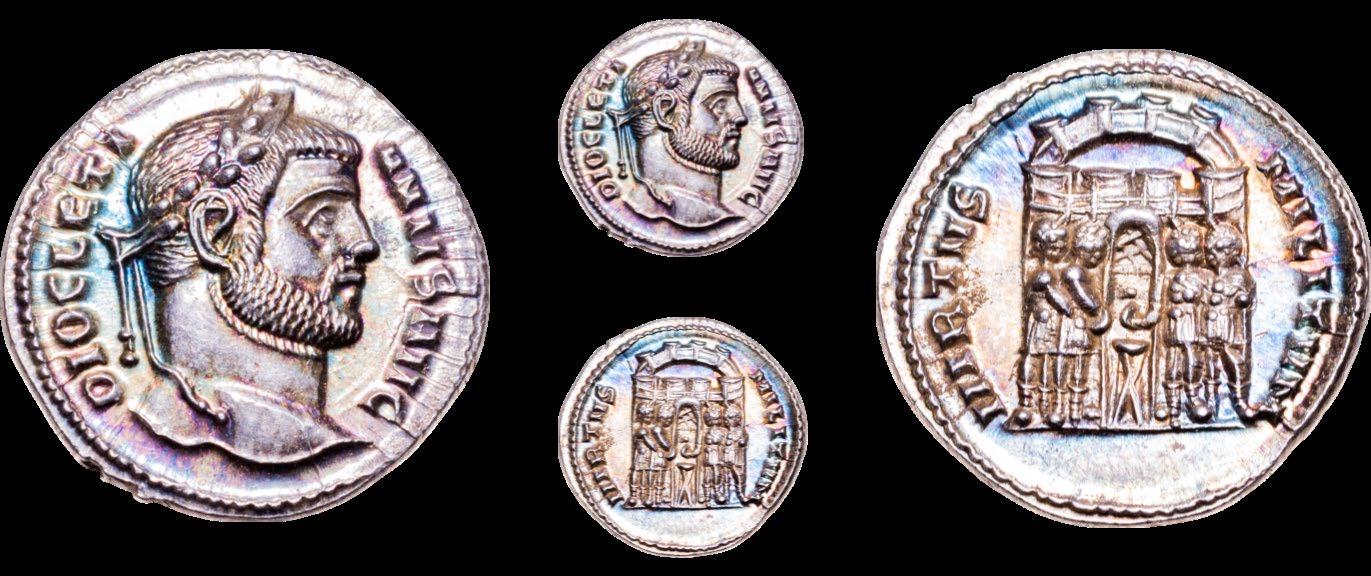
21 Diocletian (AD 284-305)
AR-Argenteus (??mm, 2.94g, ??h). Siscia mint, struck AD 294-295. Obv. DIOCLETI - ANVS AVG, Laureate head to the right. Rev. VIRTVS - MILITVM, The four tetrarchs sacrificing over a tripod in front of a city-gate with eight turrets. RIC VI 43a; Jeločnik 3a; RSC 516†m
A choice specimen with an attractive portrait. Beautiful light iridescent bluish-red toning, boldly struck and perfectly centered. Good extremely fine. 2’650
Ex Hess Divo Auction 342, 1 December 2024, Lot 121 (From an old Swiss Collection started in the 19th century).
It was Diocletian who introduced a new coin called the argenteus in the context of a comprehensive coinage reform in 294. This was a high-quality coin made of almost pure silver (95% or better). A gold aureus was worth 25 of these argentei. This reform was necessary because at that time there were only bronze and gold coins with often irregular weights. Silver coins had completely disappeared. There were only pseudo silver coins with a silver coating which usually contained less than 5% silver.
